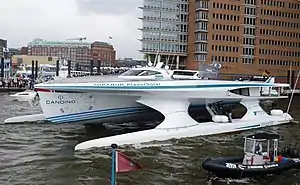Tûranor PlanetSolar
MS Tûranor PlanetSolar, known under the project name PlanetSolar, founded by the Swiss explorer Raphaël Domjan, is the largest solar-powered boat in the world[2] and launched on 31 March 2010.
 PlanetSolar in Hamburg | |
| History | |
|---|---|
| Name: | MS Tûranor PlanetSolar |
| Owner: | PlanetSolar SA from 2015 Race For Water Foundation |
| Builder: | Knierim Yachtbau, Kiel, Germany |
| Cost: | €15 million |
| Launched: | 31 March 2010 |
| General characteristics [1] | |
| Class and type: | Yacht |
| Displacement: | 85 tonnes |
| Length: | 31 m (35 m with flaps) |
| Beam: | 15 m (23 m with flaps) |
| Propulsion: |
|
| Speed: |
|
| Crew: | 4 |
In May 2012, it became the first solar electric vehicle ever to circumnavigate the globe.[3]
Today the boat is running for the Swiss foundation Race For Water.
Technical characteristics
The 31-metre boat is covered by 537 m2[4] of solar panels rated at 93 kW,[5] which in turn connect to two electric motors, one in each hull.[2] There are 8.5 tons of lithium-ion batteries in the ship's two hulls.[6] The boat's shape allows it to reach speeds of up to 10 knots (19 km/h).[1] The hull was model tested in wind tunnels and was tank tested to determine its hydrodynamics and aerodynamics. The boat was designed to be used as a luxury yacht after the record attempt was finished.[7]
It is currently being used as an ambassador for the project Race for water.

The boat is registered in Switzerland and was financed by a German entrepreneur, Immo Ströher and designed by Craig Loomes. Construction cost was €15 million.[8] The name Tûranor, derived from J.R.R. Tolkien's novel The Lord of the Rings, translates to "The Power of the Sun".[9]
Around the world
On 27 September 2010, Tûranor PlanetSolar set off from Monaco to circumnavigate the globe solely with the aid of solar power. One aim of the project was to focus public awareness on the importance of renewable energies for environmental protection.
The boat had a full-time crew of four including:[10]
- Raphaël Domjan of Switzerland, expedition leader
- Christian Ochsenbein of Switzerland, electrical engineer
- Jens Langwasser of Germany, quartermaster
- Patrick Marchesseau of France, skipper for the first half of the voyage from Monaco to Nouméa and the high-risk leg from Abu Dhabi to Port Sudan
- Erwann Le Rouzic of France, skipper for the second half of the voyage from Nouméa to Monaco
Additional crew members joined the voyage during select legs of the voyage including extra security in the Gulf of Aden.[11]
A significant stopover was Cancún, Mexico, during the 2010 United Nations Climate Change Conference held there from 29 November to 10 December 2010. During the expedition, Tûranor PlanetSolar broke two records: the fastest crossing of the Atlantic Ocean by solar boat and the longest distance ever covered by a solar electric vehicle. Tûranor PlanetSolar returned to Monaco on 4 May 2012 after 584 days sailing around the globe.
2013 voyage and transatlantic record
After an engine refit, Tûranor PlanetSolar broke its own record, crossing the Atlantic Ocean from Las Palmas to Saint Martin in the Caribbean in only 22 days, four days faster than on the circumnavigation trip. The boat left Las Palmas on 25 April and arrived in Marigot on Saint Martin on 18 May The trip led to Miami, Florida, and then continued as a scientific expedition along the Gulf Stream.[12] On the return trip the boat reached St John's, Newfoundland, on 1 August 2013 before heading back across the Atlantic.[13] The story of Tûranor PlanetSolar can be found in Kevin Desmond's 280-page Electric Boats and Ships: a History published by McFarland Books in September 2017.
See also
- Aditya, India's first solar ferry
- Earthrace, biodiesel-powered LOMOcean design
- List of circumnavigations
- List of solar-powered boats
- Solar Impulse, first solar aircraft to circumnavigate the world
- Solar vehicle
References
- "Technical Data Sheet". PlanetSolar. Archived from the original on 2010-07-05.
- Pilato, Fabrizio (26 February 2010). "PlanetSolar 100′ catamaran has 38,000 photovaltaic solar cells, set to sail in March". Mobile Magazine. Archived from the original on 2 March 2010.
- Gieffers, Hanna (4 May 2012). "Ankunft in Monaco: Solarboot schafft Weltumrundung in 584 Tagen". Spiegel Online (in German). Retrieved 5 May 2012.
- "First Circumnavigation by Solar-Powered Boat". Guinness Records.
- "PlanetSolar Unveils World's Largest Solar Boat". Environment News Service. February 27, 2010.
- "An inside look at the world's largest solar-powered boat". The Verge. June 22, 2013.
- "PlanetSolar". LOMOcean Design. Retrieved 2010-04-24.
- Behling, Frank (24 April 2010). "Das Solarschiff fährt" (in German). Kieler Nachrichten. Archived from the original on 26 April 2010.
- "A Milestone in the Progress of Solar Mobility". PlanetSolar. Archived from the original on 2010-07-05.
- "Team – Fondation PlanetSolar". www.planetsolar.swiss. Retrieved 2020-12-19.
- "Logbook – Fondation PlanetSolar". www.planetsolar.swiss. Log Entry of March 5th, 2012. Retrieved 2020-12-19.
- "PlanetSolar – four days faster across the Atlantic". Sail World. 19 May 2013. Retrieved 19 May 2013.
- Hayward, Rhonda (2 August 2013). "Solar ship visits St. John's". The Telegram. Retrieved 14 August 2016.
External links
| Wikimedia Commons has media related to Tûranor PlanetSolar (ship, 2010). |
- planetsolar.org
- lomocean.com
- Virtual Tour of the PlanetSolar in Egypt (360TOURIST Egypt)
- NavAlt, commercially viable solar ferry
